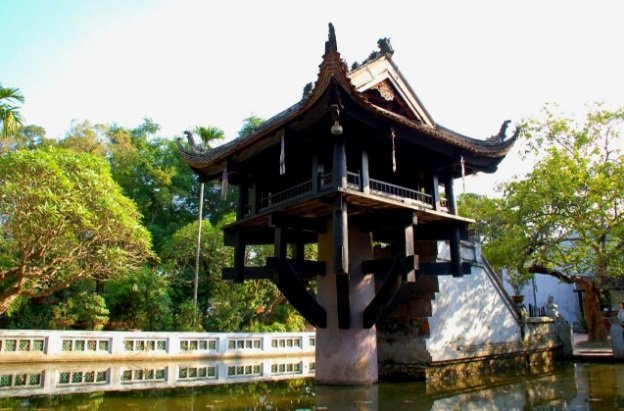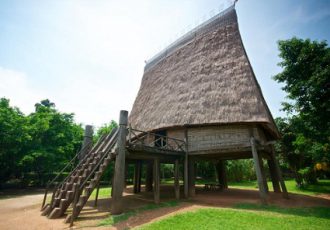The One Pillar Pagoda has become one of Vietnam’s world records since October 2012. Recognized by Asia Book of Records_ the Asia-based world records registry organization, as “The most unique architectural work in Asia”

A brief history
Officially named Dien Huu, the pagoda is much better known by the name Chua Mot Cot “One Pillar Pagoda”, due to the identifying feature of its architecture. This pagoda was built in 1049 by King Ly Thai Tong, a lifelong devout Buddhist. This construction is supposed to be the result of a dream that foretold the birth of Prince Ly Nhat Ton, after a long period of waiting for an heir to the king. In his dream, the king saw Bodhisattva GuanYin on a giant lotus growing in a square pond to the west of the royal palace, holding a baby boy. The king, therefore, decided to build the One Pillar Pagoda to worship the Bodhisattva, recreating his dream. This is why the pagoda is shaped like a giant lotus, growing in a square pond.
According to historical documents, the single-pillar architecture originated before the Ly dynasty. Two other “single-pillar” works are known, one in Ninh Binh dating from 981-1005 and another in Thang Long built in 1058. This architecture is therefore one of the specialities of ancient Vietnamese architecture.
The architecture
The One Pillar Pagoda consists of two parts: the pillar which takes the form of a lotus bell, and the wooden pagoda above it embodies the flower.
The pagoda itself is named Lien Hoa Dai “the lotus flower”, formed by a wooden floor measuring 3x3m. Unlike other architectural rooms in Vietnam which contained at least three compartments, Lien Hoa Dai is only one compartment, where the statue of the Bodhisattva GuanYin is placed. However, the pagoda still retains the curved roof and especially the image of the two dragons flanking the moon on top, which are the identifying features of Vietnamese architecture.

The pillar is actually two stacked concrete blocks measuring 1.2m in diameter, and 4m in total height. The block below is planted in the ground, and the one above is actually a system of connected bars, serving as the base of the pagoda.
Built during the reign of one of Vietnam’s most pious Buddhist kings, the One Pillar Pagoda gained undeniable affection from King Ly Thai Tong’s successors, as evidenced by the embellishments and restorations they made to it. In 1105, King Ly Nhan Tong had two towers covered with white porcelain built in front of the pagoda. In 1108, the imperial concubine Y Lan had a giant bell of 12,000kg forged, named Giac The Chung_ The Bell of the People’s Awakening. However, because of its enormous size, it could not be hung, and had to be placed in a nearby plot where many turtles lived. It is therefore called Quy Dien_the turtle plot. Nowadays, nothing remains of this bell, because in the 15th century when the Mings invaded the country and occupied Thang Long, during the siege of Le Loi’s army, they used the leather of the bell to forge weapons…
The first restoration of the pagoda was carried out from 1840 to 1850 by the Nguyen kings. The second was in 1922, carried out by the École Française d’Extrême-Orient. Unfortunately, on 11 September 1954, the pagoda was mined by the French colonial government before they left. This single-pillar pagoda was restored to its original form after the Vietnamese government’s reconstruction.
Another treasure of the pagoda is the original Bodh-Gaya pagoda fig tree which was given to President Ho Chi Minh during his visit to India. It has been planted at the site of the One Pillar Pagoda since 1958.
The One Pillar Pagoda has become one of the official symbols of Hanoi along with the Khue Van Cac Pavilion at the Temple of Literature.



